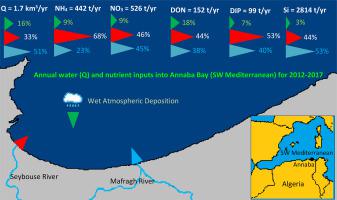Marine Chemistry ( IF 3.0 ) Pub Date : 2020-12-17 , DOI: 10.1016/j.marchem.2020.103915 Makhlouf Ounissi , Hadjer Laskri , Omar Ramzi Ziouch , Dubravko Justić

|
This study describes the first simultaneous long-term effort to examine the nutrient inputs to the southern Mediterranean Sea from rivers and wet atmospheric deposition. Extensive daily rainwater sampling (280 samples) from the Annaba region (SW Mediterranean Sea, Algeria) and from river discharges (144 samples) at two river outlets feeding the Annaba Bay, the Seybouse River (SR) and the Mafragh River (MR),were collected and analyzed for dissolved nutrients from 2012 until 2017. During the 6-year study period, the Annaba region experienced contrasted hydrological conditions varying from heavy rainfall events during winter that have triggered large river flooding in 2012 and 2015 to the severe drought of 2016, which have profoundly affected both the atmospheric and riverine freshwater and nutrient inputs. The annual freshwater volume delivered to Annaba Bay averaged approximately 1.7 km3, of which 51% was from MR, 33% from SR, and 16% from precipitation. Precipitation over the Annaba region was associated with unusually high levels of DIP and DSi, resulting in deposition rates (0.54 mmol Si m−2 yr−1and 6.22 mmol P m−2 yr−1, respectively) that are several times higher compared to the average values reported for the Mediterranean region. In contrast, both the DIN and DON deposition rates were relatively low (16.2 and 4.7 mmol N m−2 yr−1, respectively) compared to the values reported for the Mediterranean region. Interestingly, the levels of nitrogen compounds in rainwater were similar to those in the MR waters. For all nutrient species analyzed in this study, SR waters always contained higher nutrient levels compared to those in MR and rainwater. The majority of nutrient loading entering Annaba Bay was delivered through the riverine inputs, averaging 2744, 962 and 92 t yr−1 for DSi, DIN and DIP, respectively. The wet atmospheric deposition contributed only 2.5% of DSi, 10% of DIN and 7% of DIP total annual flux. The riverine stoichiometric N:P and Si:N ratios were imbalanced in most cases, averaging 28 and 0.84, respectively. The N:P and Si:N ratios in rainwater were more balanced, particularly during the dry season when Saharan airflow dominated the region and supplied more DIP and DSi.
中文翻译:

北非西南地中海地区的河流和湿润大气营养物输入
这项研究描述了同时进行的第一项长期努力,旨在研究河流和湿润大气沉积物向地中海南部注入的营养素。每天从安纳巴地区(阿尔及利亚西南地中海)和两处安纳巴湾,塞布兹河(SR)和马夫拉河(MR)的河流出口处的河水排放(144个样品)进行大量雨水日常采样(280个采样),收集并分析了2012年至2017年期间的溶解性养分。在为期6年的研究期间,安纳巴地区经历了相反的水文条件,从冬季的暴雨事件(导致2012年和2015年的大洪水泛滥到2016年的严重干旱) ,这极大地影响了大气和河流淡水和养分的输入。3,其中51%来自MR,33%来自SR和16%来自降水。安纳巴地区的降水与DIP和DSi的异常高水平有关,导致沉积速率(分别为0.54 mmol Si m -2 yr -1和6.22 mmol P m -2 yr -1)比高出几倍。地中海地区报告的平均值。相反,DIN和DON沉积速率均相对较低(N m -2 yr -1为16.2和4.7 mmol N m,分别与地中海地区报告的值进行比较。有趣的是,雨水中的氮化合物含量与MR水相似。对于本研究中分析的所有营养物质,与MR和雨水相比,SR水始终含有较高的营养水平。进入安纳巴湾的大部分养分负荷是通过河流投入物输送的,平均输入时间为2744、962和92 t yr -1分别适用于DSi,DIN和DIP。潮湿的大气沉积仅贡献了2.5%的DSi,10%的DIN和7%的DIP年通量。河流化学计量比的N:P和Si:N比在大多数情况下不平衡,分别平均为28和0.84。雨水中的N:P和Si:N比更加平衡,特别是在干旱季节,当时撒哈拉气流主导该地区并提供更多的DIP和DSi。











































 京公网安备 11010802027423号
京公网安备 11010802027423号